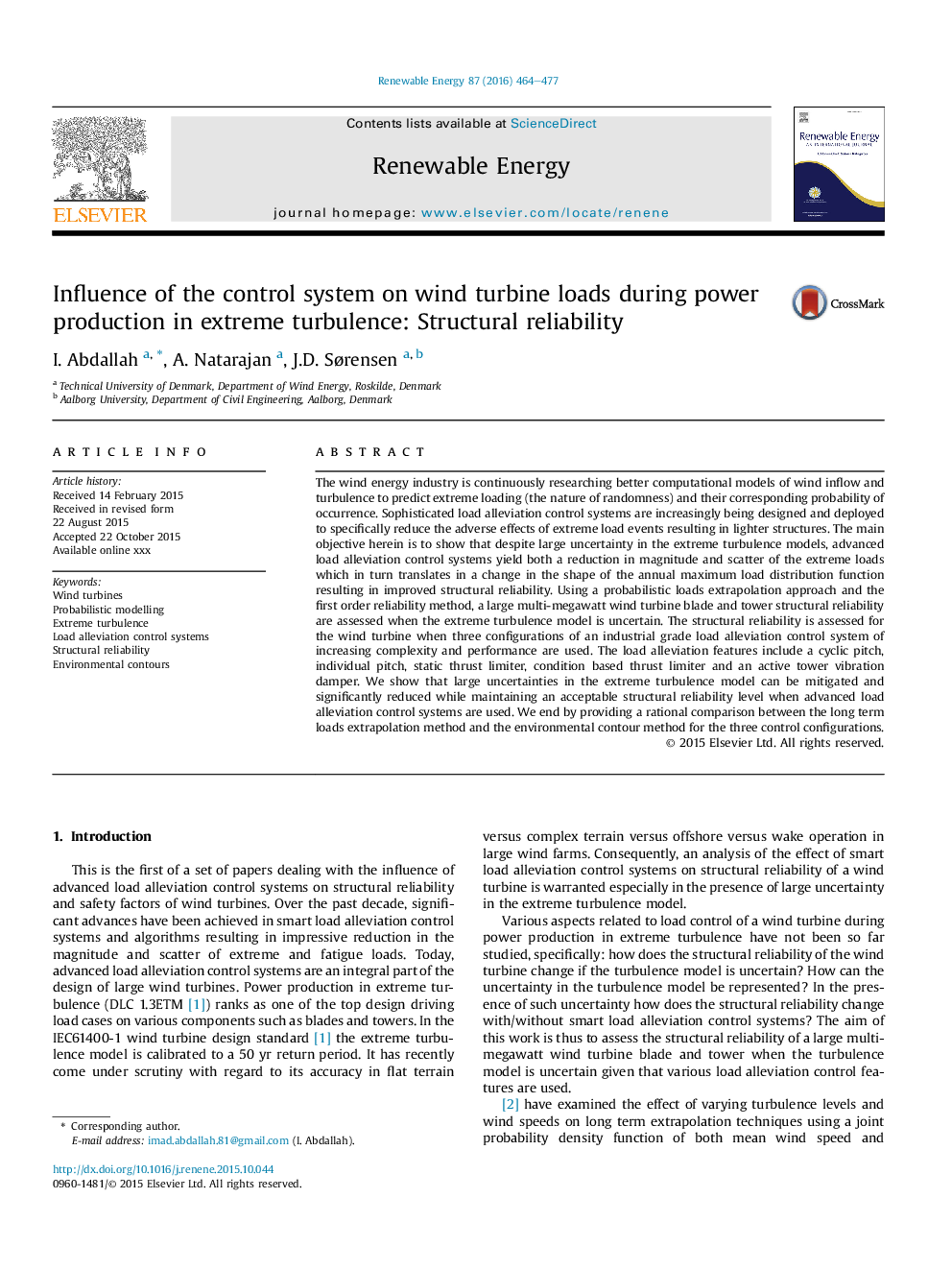| کد مقاله | کد نشریه | سال انتشار | مقاله انگلیسی | نسخه تمام متن |
|---|---|---|---|---|
| 10293988 | 512447 | 2016 | 14 صفحه PDF | دانلود رایگان |
عنوان انگلیسی مقاله ISI
Influence of the control system on wind turbine loads during power production in extreme turbulence: Structural reliability
ترجمه فارسی عنوان
تأثیر سیستم کنترل بر بارهای توربین باد هنگام تولید برق در آشفتگی شدید: قابلیت اطمینان ساختاری
دانلود مقاله + سفارش ترجمه
دانلود مقاله ISI انگلیسی
رایگان برای ایرانیان
کلمات کلیدی
توربین های بادی، مدل سازی احتمالی، آشفتگی شدید، سیستم های کنترل کاهش بار، قابلیت اطمینان ساختاری خطوط محیطی،
ترجمه چکیده
صنعت انرژی باد به طور مداوم مدل های محاسباتی بیشتری از جریان باد و آشفتگی را برای پیش بینی بارگذاری شدید (ماهیت تصادفی) و احتمال وقوع آن در نظر می گیرد. سیستم های کنترل کاهش راندمان پیشرفته به طور فزاینده ای طراحی شده و به کار گرفته شده اند تا به طور خاص کاهش اثرات نامطلوب رخدادهای بار افراطی را که منجر به ساختار سبک تر شود. هدف اصلی در اینجا این است که نشان می دهد که علیرغم عدم اطمینان زیاد در مدل های آشفتگی شدید، سیستم های کنترل پیشرفت بار، هر دو کاهش میزان و پراکندگی بارهای شدید را انجام می دهند که به نوبه خود باعث تغییر در شکل توزیع حداکثر بار سالانه می شود عملکرد باعث بهبود قابلیت اطمینان ساختاری می شود. با استفاده از رویکرد استخراج احتمالات بار و روش اعتبارسنجی مرتبه اول، پمپ توربین بادی چند مگاواتی و قابلیت اطمینان ساختاری برج هنگام ارزیابی می شود زمانی که مدل آشفتگی شدید نامشخص است. قابلیت اطمینان ساختاری برای توربین بادی مورد ارزیابی قرار می گیرد، زمانی که سه تنظیم از یک سیستم کنترل کاهش بار بار صنعتی از افزایش پیچیدگی و عملکرد استفاده می شود. ویژگی های کاهش بار عبارتند از: چرخه چرخه ای، زمین فردی، محدود کننده محرک استاتیک، محدود کننده محرک شرایط و یک دمپر ارتعاش برج فعال. ما نشان می دهد که عدم اطمینان های بزرگ در مدل آشفتگی شدید می تواند کاهش یابد و به طور قابل توجهی کاهش می یابد در حالی که حفظ قابلیت اطمینان ساختاری قابل قبول در هنگام استفاده از سیستم های کنترل بار کاهش بار پیشرفته. ما با ارائه یک مقایسه منطقی بین روش استخراج طول بار بارها و روش کانتور محیط برای سه پیکربندی کنترل پایان می یابیم.
موضوعات مرتبط
مهندسی و علوم پایه
مهندسی انرژی
انرژی های تجدید پذیر، توسعه پایدار و محیط زیست
چکیده انگلیسی
The wind energy industry is continuously researching better computational models of wind inflow and turbulence to predict extreme loading (the nature of randomness) and their corresponding probability of occurrence. Sophisticated load alleviation control systems are increasingly being designed and deployed to specifically reduce the adverse effects of extreme load events resulting in lighter structures. The main objective herein is to show that despite large uncertainty in the extreme turbulence models, advanced load alleviation control systems yield both a reduction in magnitude and scatter of the extreme loads which in turn translates in a change in the shape of the annual maximum load distribution function resulting in improved structural reliability. Using a probabilistic loads extrapolation approach and the first order reliability method, a large multi-megawatt wind turbine blade and tower structural reliability are assessed when the extreme turbulence model is uncertain. The structural reliability is assessed for the wind turbine when three configurations of an industrial grade load alleviation control system of increasing complexity and performance are used. The load alleviation features include a cyclic pitch, individual pitch, static thrust limiter, condition based thrust limiter and an active tower vibration damper. We show that large uncertainties in the extreme turbulence model can be mitigated and significantly reduced while maintaining an acceptable structural reliability level when advanced load alleviation control systems are used. We end by providing a rational comparison between the long term loads extrapolation method and the environmental contour method for the three control configurations.
ناشر
Database: Elsevier - ScienceDirect (ساینس دایرکت)
Journal: Renewable Energy - Volume 87, Part 1, March 2016, Pages 464-477
Journal: Renewable Energy - Volume 87, Part 1, March 2016, Pages 464-477
نویسندگان
I. Abdallah, A. Natarajan, J.D. Sørensen,
